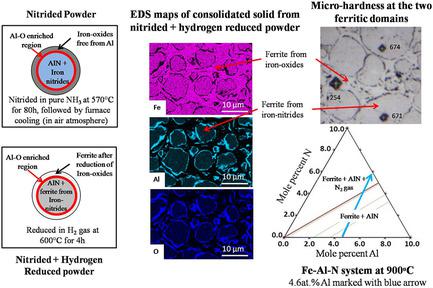当前位置:
X-MOL 学术
›
Steel Res. Int.
›
论文详情
Our official English website, www.x-mol.net, welcomes your
feedback! (Note: you will need to create a separate account there.)
Nitride Dispersion Strengthened Steel Development after Sintering of Nitrided Fe-4.6 at% Al Alloy Powder
Steel Research International ( IF 1.9 ) Pub Date : 2021-06-05 , DOI: 10.1002/srin.202100174 Akeshwar Singh Yadav 1 , Philipp Kürnsteiner 2, 3 , Eric A. Jägle 2, 4 , K.N. Sasidhar 1, 2 , Sai Ramudu Meka 1
Steel Research International ( IF 1.9 ) Pub Date : 2021-06-05 , DOI: 10.1002/srin.202100174 Akeshwar Singh Yadav 1 , Philipp Kürnsteiner 2, 3 , Eric A. Jägle 2, 4 , K.N. Sasidhar 1, 2 , Sai Ramudu Meka 1
Affiliation

|
The development of a composite microstructure with hard aluminum nitrides (AlN) dispersed in a soft ferritic iron-based solid is achieved through the powder metallurgy route. Fe-4.6 at% Al alloy powders subjected to two different thermochemical treatments viz. nitriding and nitriding followed by hydrogen reduction are consolidated by spark plasma sintering (SPS) at 900 °C. The final sintered microstructure is characterized with the help of optical, scanning electron, and transmission electron microscopy along with X-ray diffraction for detailed phase analysis. The microstructures of the nitrided and sintered compacts are observed to be significantly affected by two factors: 1) presence of oxide phases on the surface of the powder particles before SPS and 2) evolution of nitrogen gas due to dissociation of iron nitrides during sintering. These result in a very complicated microstructure. However, for nitrided powders, performing a hydrogen reduction step before SPS lead to a microstructure composed of precipitation-hardened particle cores due to dispersion of nanosized AlN precipitates, with a soft, ferritic interparticle region. This composite microstructure achieved through the powder metallurgy route, which can be finely tuned by controlling the nitriding, oxidation, and sintering parameters, is envisioned to be greatly beneficial for several engineering applications such as automotive components.
中文翻译:

氮化 Fe-4.6 at% 铝合金粉末烧结后氮化物弥散强化钢的发展
硬质氮化铝 (AlN) 分散在软质铁素体铁基固体中的复合微观结构的开发是通过粉末冶金路线实现的。Fe-4.6 at% 铝合金粉末经过两种不同的热化学处理,即。在 900 °C 下通过放电等离子烧结 (SPS) 对渗氮和渗氮后的氢还原进行固结。借助光学、扫描电子和透射电子显微镜以及 X 射线衍射对最终烧结的微观结构进行表征,以进行详细的相分析。观察到氮化和烧结压块的微观结构受到两个因素的显着影响:1) 在 SPS 之前粉末颗粒表面上存在氧化物相和 2) 由于氮化铁在烧结过程中解离而释放出氮气。这些导致非常复杂的微观结构。然而,对于氮化粉末,在 SPS 之前执行氢还原步骤会导致微观结构由沉淀硬化颗粒核心组成,这是由于纳米尺寸的 AlN 沉淀物的分散,具有软的铁素体颗粒间区域。这种通过粉末冶金路线实现的复合微观结构可以通过控制氮化、氧化和烧结参数进行微调,预计将极大地有益于多种工程应用,例如汽车部件。
更新日期:2021-06-05
中文翻译:

氮化 Fe-4.6 at% 铝合金粉末烧结后氮化物弥散强化钢的发展
硬质氮化铝 (AlN) 分散在软质铁素体铁基固体中的复合微观结构的开发是通过粉末冶金路线实现的。Fe-4.6 at% 铝合金粉末经过两种不同的热化学处理,即。在 900 °C 下通过放电等离子烧结 (SPS) 对渗氮和渗氮后的氢还原进行固结。借助光学、扫描电子和透射电子显微镜以及 X 射线衍射对最终烧结的微观结构进行表征,以进行详细的相分析。观察到氮化和烧结压块的微观结构受到两个因素的显着影响:1) 在 SPS 之前粉末颗粒表面上存在氧化物相和 2) 由于氮化铁在烧结过程中解离而释放出氮气。这些导致非常复杂的微观结构。然而,对于氮化粉末,在 SPS 之前执行氢还原步骤会导致微观结构由沉淀硬化颗粒核心组成,这是由于纳米尺寸的 AlN 沉淀物的分散,具有软的铁素体颗粒间区域。这种通过粉末冶金路线实现的复合微观结构可以通过控制氮化、氧化和烧结参数进行微调,预计将极大地有益于多种工程应用,例如汽车部件。











































 京公网安备 11010802027423号
京公网安备 11010802027423号